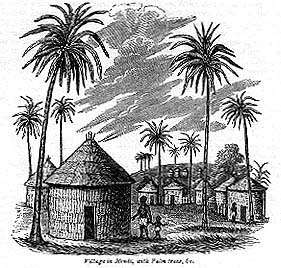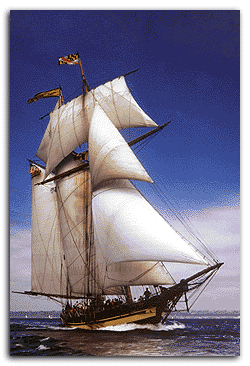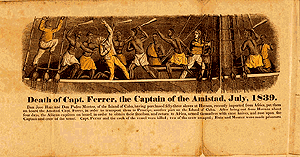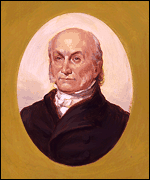

Voyage of the Amistad
Sengbe Pieh, the man who would become known
as "Cinque", was "stolen and sold into slavery while "walking in the road"
near his village along the Gallinas River in northwest Africa in 1839.
Of the 52 other Africans who would eventually find themselves aboard the
Amistad, nine others were captured the same way. Six were seized when their
villages were raided by larger parties of slavers, probably "soldiers"
hired by rival chiefs or kings. Some were condemned and sold as punishment
for committing crimes within their villages. And several others were sold
to pay off debts. However they had become slaves, once in captivity,
the Africans were marched from the interior to the delta at the mouth of
the Gallinas River. Here they came into Spanish hands. The Spaniards kept
them in baracoons -- crude structures, many of them little more than walled,
open-air pens, with high, stout walls -- built on the marshy, low-lying
islands along the river. The slaves were chained together in pairs by leg
irons to discourage escape or revolt. Meanwhile, beyond the baracoon walls,
African and European traders bargained -- trading the men, women and children
for rum, tobacco, muskets, gunpowder, cloth and other goods.
The ship that carried the Africans across the
Atlantic was the Tecora, a brig, built specially for the slave trade, for
maneuverability and, above all, speed, to evade the British patrols intent
on stopping this illegal traffic.
However they had become slaves, once in captivity,
the Africans were marched from the interior to the delta at the mouth of
the Gallinas River. Here they came into Spanish hands. The Spaniards kept
them in baracoons -- crude structures, many of them little more than walled,
open-air pens, with high, stout walls -- built on the marshy, low-lying
islands along the river. The slaves were chained together in pairs by leg
irons to discourage escape or revolt. Meanwhile, beyond the baracoon walls,
African and European traders bargained -- trading the men, women and children
for rum, tobacco, muskets, gunpowder, cloth and other goods.
The ship that carried the Africans across the
Atlantic was the Tecora, a brig, built specially for the slave trade, for
maneuverability and, above all, speed, to evade the British patrols intent
on stopping this illegal traffic. When the Tecora was ready to sail, the slaves
were herded out of the baracoons, marched to the water's edge, forced into
large wooden canoes and ferried out to the slave ship beyond the surf.
In all liklihood, none of the captives had ever been to sea before. The
European slavers and their African workers, members of a coastal tribe,
the Kru, worked rapidly. If a British cruiser suddenly appeared on the
horizon, the venture would be lost -- and the slaves would likely be thrown
into the surf to drown.
When the Tecora was ready to sail, the slaves
were herded out of the baracoons, marched to the water's edge, forced into
large wooden canoes and ferried out to the slave ship beyond the surf.
In all liklihood, none of the captives had ever been to sea before. The
European slavers and their African workers, members of a coastal tribe,
the Kru, worked rapidly. If a British cruiser suddenly appeared on the
horizon, the venture would be lost -- and the slaves would likely be thrown
into the surf to drown. Once loaded, the slave ship quickly weighed anchor and sailed
off. The voyage, known as the "Middle Passage" across the Atlantic, took
two months.
On board the Tecora, the slaves were packed
into a dark, stooped space called the slave deck, about four feet high,
built below the main deck, above the hold. In the testimony given later
by the Amistad Africans about this nightmare voyage, the most vivid aspect
of the experience was being cramped here in this suffocating, fetid darkness,
being tossed about by the rolling sea. Both Cinque and another captive,
Grabeau, reenacted their confinement by getting down on the floor and curling
into hunched balls.
Periodically, they were brought up on deck and
fed rice. If some of the captives tried to starve themselves, as often
happened, they were whipped and forced to eat. Over the two months they
were at sea, water supplies ran low, and disease spread through the close-packed,
unventilated slave deck. By the time theTecora had crossed the Atlantic,
a third of the Africans had died.
As theTecora neared Cuba, the captain had the
surviving slaves brought up on deck and prepared for sale. They were bathed,
clothed and fed extra rations to make them appear as healthy as possible.
(Healthy adult males were worth about $450 apiece.) The Tecora unloaded
her cargo at night, landing the slaves by small boats in a secluded inlet
a few miles from Havana. The Africans were then marched three miles through
the jungle. At daylight, they were led into baracoons, already teeming
with several hundred fellow captives. They had reached the slave market,
where imported Africans were auctioned off to Cuba's sugar and coffee planters.
Two young Spanish sugar planters, Jose Ruiz
and Pedro Montes, bought 53 of the Africans for their plantations near
Puerto Principe, several hundred miles away. They had obtained passports
for each of slaves so, if they were stopped by British patrols, they could
claim that the slaves were Cuban-born, since importing Africans was illegal
in Cuba. Each slave was also given a Spanish name, (Sengbe Pieh became
"Jose Cinque). They then loaded their new slaves on the Amistad, a coastal
schooner.
The Amistad -- the name means 'friendship' --
put off from Havana for Puerto Principe on June 28, 1839. In addition to
Ruiz and Montes, the ship carried Captain Ramon Ferrer, two crew members,
and a cook named Celestino.
The slaves were kept in the hold. On the second
day out, the wind shifted. Now facing a longer voyage than he had anticipated,
the captain cut the slaves' rations to one banana, two potatoes, and a
small cup of water a day. Some of the Africans tried to drink more than
their ration so Ruiz had them strung up on deck and flogged by the crew,
and their wounds rubbed with gunpowder and vinegar.
Cinque approached the cook and asked in sign
language what was happening to the Africans on deck. Cinque's interpretation
of the cook's response was that the crew planned to slaughter and eat the
Africans. Fearing for his life, Cinque, on the third night out, found a
nail which he used to work open the lock securing his iron collar, then
freed his fellow captives. Above them, a storm was occupying the crew;
so no one on deck heard the activity in the hold, where the Africans were
arming themselves with steel sugar cane knives from the schooner's cargo.
Once loaded, the slave ship quickly weighed anchor and sailed
off. The voyage, known as the "Middle Passage" across the Atlantic, took
two months.
On board the Tecora, the slaves were packed
into a dark, stooped space called the slave deck, about four feet high,
built below the main deck, above the hold. In the testimony given later
by the Amistad Africans about this nightmare voyage, the most vivid aspect
of the experience was being cramped here in this suffocating, fetid darkness,
being tossed about by the rolling sea. Both Cinque and another captive,
Grabeau, reenacted their confinement by getting down on the floor and curling
into hunched balls.
Periodically, they were brought up on deck and
fed rice. If some of the captives tried to starve themselves, as often
happened, they were whipped and forced to eat. Over the two months they
were at sea, water supplies ran low, and disease spread through the close-packed,
unventilated slave deck. By the time theTecora had crossed the Atlantic,
a third of the Africans had died.
As theTecora neared Cuba, the captain had the
surviving slaves brought up on deck and prepared for sale. They were bathed,
clothed and fed extra rations to make them appear as healthy as possible.
(Healthy adult males were worth about $450 apiece.) The Tecora unloaded
her cargo at night, landing the slaves by small boats in a secluded inlet
a few miles from Havana. The Africans were then marched three miles through
the jungle. At daylight, they were led into baracoons, already teeming
with several hundred fellow captives. They had reached the slave market,
where imported Africans were auctioned off to Cuba's sugar and coffee planters.
Two young Spanish sugar planters, Jose Ruiz
and Pedro Montes, bought 53 of the Africans for their plantations near
Puerto Principe, several hundred miles away. They had obtained passports
for each of slaves so, if they were stopped by British patrols, they could
claim that the slaves were Cuban-born, since importing Africans was illegal
in Cuba. Each slave was also given a Spanish name, (Sengbe Pieh became
"Jose Cinque). They then loaded their new slaves on the Amistad, a coastal
schooner.
The Amistad -- the name means 'friendship' --
put off from Havana for Puerto Principe on June 28, 1839. In addition to
Ruiz and Montes, the ship carried Captain Ramon Ferrer, two crew members,
and a cook named Celestino.
The slaves were kept in the hold. On the second
day out, the wind shifted. Now facing a longer voyage than he had anticipated,
the captain cut the slaves' rations to one banana, two potatoes, and a
small cup of water a day. Some of the Africans tried to drink more than
their ration so Ruiz had them strung up on deck and flogged by the crew,
and their wounds rubbed with gunpowder and vinegar.
Cinque approached the cook and asked in sign
language what was happening to the Africans on deck. Cinque's interpretation
of the cook's response was that the crew planned to slaughter and eat the
Africans. Fearing for his life, Cinque, on the third night out, found a
nail which he used to work open the lock securing his iron collar, then
freed his fellow captives. Above them, a storm was occupying the crew;
so no one on deck heard the activity in the hold, where the Africans were
arming themselves with steel sugar cane knives from the schooner's cargo. At 4:00 a.m., the Africans struck, killing Captain
Ferrer and Celestino, the cook. The two other members of the crew either
died in the melee or escaped overboard. Ruiz and Montes were captured and
brought to the quarterdeck, where the Africans ordered them to sail the
vessel in the direction of the rising sun -- back to Africa.
The Africans did not know how to operate the
schooner or navigate their way back across the Atlantic. Trying to save
themselves, the Spaniards slowed the sailing by day when the vessel pointed
eastwards, then brought the schooner about during the night, fervently
hoping they would attract the notice of other vessels. These tactics carried
the Amistad north, up the eastern coastline of the United States, and ultimately
to New England waters where it met the U.S.S. Washington. The Africans
were immediately taken into custody and brought into New London, Connecticut.
It was August 26, 1839.
Even while the schooner was still offshore,
word spread of a mysterious ship manned by armed, fierce-looking blacks,
apparently roaming coastal waters off New York. When the Africans were
moved to the jail in Hartford, Connecticut, throngs of curious visitors
crowded the cell windows to see the exotic captives. The jailers charged
admission. An artist named James Sheffield sketched Cinque within a few
days of his arrival in New London, and the image was published in the New
York Sun and sold widely as a lithograph. Wax figures of the Africans went
on tour up and down the northern Atlantic seaboard. A Boston artist painted
a 135-ft. mural depicting the murder of Captain Ferrer that was translated
into engravings and woodcuts.
At 4:00 a.m., the Africans struck, killing Captain
Ferrer and Celestino, the cook. The two other members of the crew either
died in the melee or escaped overboard. Ruiz and Montes were captured and
brought to the quarterdeck, where the Africans ordered them to sail the
vessel in the direction of the rising sun -- back to Africa.
The Africans did not know how to operate the
schooner or navigate their way back across the Atlantic. Trying to save
themselves, the Spaniards slowed the sailing by day when the vessel pointed
eastwards, then brought the schooner about during the night, fervently
hoping they would attract the notice of other vessels. These tactics carried
the Amistad north, up the eastern coastline of the United States, and ultimately
to New England waters where it met the U.S.S. Washington. The Africans
were immediately taken into custody and brought into New London, Connecticut.
It was August 26, 1839.
Even while the schooner was still offshore,
word spread of a mysterious ship manned by armed, fierce-looking blacks,
apparently roaming coastal waters off New York. When the Africans were
moved to the jail in Hartford, Connecticut, throngs of curious visitors
crowded the cell windows to see the exotic captives. The jailers charged
admission. An artist named James Sheffield sketched Cinque within a few
days of his arrival in New London, and the image was published in the New
York Sun and sold widely as a lithograph. Wax figures of the Africans went
on tour up and down the northern Atlantic seaboard. A Boston artist painted
a 135-ft. mural depicting the murder of Captain Ferrer that was translated
into engravings and woodcuts.  A team of New York abolitionists, led by Lewis
Tappan, formed the Amistad Committee to defend the Africans' freedom in
the courts. The abolitionists set up an impromptu schoolhouse and missionary
station in the jail to teach the captives English, reading, and the Gospel
to demonstrate to skeptical white Americans that these people were capable
of being "civilized" without being enslaved.
As a legal case, the Amistad incident quickly
became a tangle of competing claims and contradictory legal issues. Ruiz
and Montes filed suit to recover their "property," including the cargo
and the Africans. New York abolitionists hired New Haven attorney Roger
S. Baldwin to argue on the Africans' behalf. He claimed that the Africans
had been illegally kidnapped and enslaved -- illegally because Spain had
outlawed the African slave trade -- and that they therefore had had the
right to free themselves by whatever means they could muster. The government
of Spain formally demanded custody of the Africans so that they could stand
trial in Cuba for murder and piracy.
After two years of legal maneuvering, the case
reached the U.S. Supreme Court. For the oral arguments, former U.S. President
John Quincy Adams joined Baldwin on the abolitionists' team. The Court
found that the Africans had been illegally enslaved and had thus exercised
a natural right to fight for their freedom, but the Court stopped short
of ordering their return to Africa.
Elated at the affirmation of their freedom,
but supremely frustrated at still not being able to return home, the Africans
relocated to Farmington, Connecticut. The Amistad Committee turned its
efforts to raising funds to pay for the return voyage, organizing a series
of appeals in local churches where the Africans told their stories and
demonstrated the results of their education and Christian conversions.
When the fund reached $1,840, the Amistad Committee was able to charter
the barque, Gentleman, to undertake the return voyage. Several ministers
and their families accompanied 35 Amistad Africans on the return voyage.
They planned to set up a "Mendi" mission near Cinque's town, establish
themselves, and disseminate not only the gospel, but American habits of
commerce, dress and morality.
A team of New York abolitionists, led by Lewis
Tappan, formed the Amistad Committee to defend the Africans' freedom in
the courts. The abolitionists set up an impromptu schoolhouse and missionary
station in the jail to teach the captives English, reading, and the Gospel
to demonstrate to skeptical white Americans that these people were capable
of being "civilized" without being enslaved.
As a legal case, the Amistad incident quickly
became a tangle of competing claims and contradictory legal issues. Ruiz
and Montes filed suit to recover their "property," including the cargo
and the Africans. New York abolitionists hired New Haven attorney Roger
S. Baldwin to argue on the Africans' behalf. He claimed that the Africans
had been illegally kidnapped and enslaved -- illegally because Spain had
outlawed the African slave trade -- and that they therefore had had the
right to free themselves by whatever means they could muster. The government
of Spain formally demanded custody of the Africans so that they could stand
trial in Cuba for murder and piracy.
After two years of legal maneuvering, the case
reached the U.S. Supreme Court. For the oral arguments, former U.S. President
John Quincy Adams joined Baldwin on the abolitionists' team. The Court
found that the Africans had been illegally enslaved and had thus exercised
a natural right to fight for their freedom, but the Court stopped short
of ordering their return to Africa.
Elated at the affirmation of their freedom,
but supremely frustrated at still not being able to return home, the Africans
relocated to Farmington, Connecticut. The Amistad Committee turned its
efforts to raising funds to pay for the return voyage, organizing a series
of appeals in local churches where the Africans told their stories and
demonstrated the results of their education and Christian conversions.
When the fund reached $1,840, the Amistad Committee was able to charter
the barque, Gentleman, to undertake the return voyage. Several ministers
and their families accompanied 35 Amistad Africans on the return voyage.
They planned to set up a "Mendi" mission near Cinque's town, establish
themselves, and disseminate not only the gospel, but American habits of
commerce, dress and morality. The Gentleman arrived in Freetown, Sierra Leone,
in mid-January 1842 -- just about three years exactly after Sengbe had
been kidnapped into slavery. The Africans' reception was festive and excited,
and some of them found acquaintances in the crowd that greeted them. But
they also found grim news: Sengbe learned that the interior had been ravaged
by slaving wars, and that his village and most of his family had been wiped
out.
Once back on home ground, most of the Amistad
Africans drifted away from the American missionaries, including Sengbe,
himself.
The Gentleman arrived in Freetown, Sierra Leone,
in mid-January 1842 -- just about three years exactly after Sengbe had
been kidnapped into slavery. The Africans' reception was festive and excited,
and some of them found acquaintances in the crowd that greeted them. But
they also found grim news: Sengbe learned that the interior had been ravaged
by slaving wars, and that his village and most of his family had been wiped
out.
Once back on home ground, most of the Amistad
Africans drifted away from the American missionaries, including Sengbe,
himself.
Answer the following questions:
39. How did Cinque get his name?
40. Why did the slaves on the Amistad revolt?
41. How did the Supreme Court decide the Amistad case?
42. Did the Africans on the Amistad ever return to their
homeland?
I recommend Steven Spielberg's excellent film version
of this event, entitled "Amistad".

 Return
to Study Guide #1
Return
to Study Guide #1
 Revised
February 1, 2004
Revised
February 1, 2004
by Tom Gallup, e-mail address: [email protected]
West Valley College
http://www.westvalley.edu/wvc/ss/gallup/gallup.html








